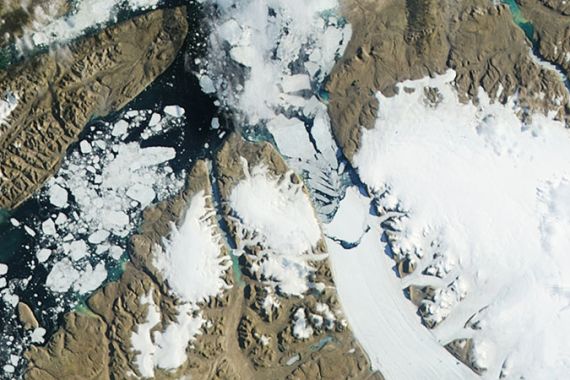Massive iceberg breaks off Greenland glacier
An iceberg twice the size of Manhattan breaks free from Greenland’s Petermann Glacier, scientists say.

A massive iceberg twice the size of Manhattan has broken away from Greenland’s Petermann Glacier, scientists have said.
“The floating extension (of the glacier) is breaking apart,” Eric Rignot of NASA’s Jet Propulsion Laboratory said in a statement on Thursday.
Keep reading
list of 4 itemsLost Futures
Photos: Greek valley that became a lake stirs drought debate
Botswana threatens to send 20,000 elephants to Germany
“It is not a collapse, but it is certainly a significant event.”
This is the second time in less than two years that the Petermann Glacier has calved a monstrous ice island. In 2010, it unleashed another massive ice chunk into the sea.
The latest break was observed by NASA’s Aqua satellite, which passes over the North Pole several times a day, and was noted by Trudy Wohlleben of the Canadian Ice Service.
“At this time of year, we’re always watching the Petermann Glacier,” Wohlleben said, because it can spawn big icebergs that invade North Atlantic shipping lanes or imperil oil platforms in the Grand Banks off Newfoundland.
Climate change
A large piece of the 2010 iceberg did just that, but caused no damage, she said by telephone.
One difference between the 2010 event and this one is that the present ice island broke off further upstream, where the ice was right up against the fjord’s rocky sidewalls, effectively damming the glacier’s seaward movement.
NASA images showed the iceberg calving – breaking off from a floating river of ice called an ice tongue, and moving downstream along a fjord on Greenland’s northwest coast.
A rift in the ice had been identified in 2001, but on Monday a crack was evident.
On Tuesday, the satellite spied a bigger gap between the glacier and the iceberg, and the ice chunks further downstream were breaking up, NASA said online.
Andreas Muenchow, an Arctic oceanographer at the University of Delaware, said climate change was a factor in the current state of the Petermann Glacier.
He said this glacier is as far back toward the land as it has been since the start of the Industrial Revolution more than 150 years ago.